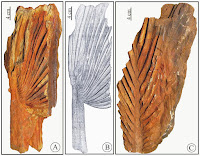The genus Mahonia comprises evergreen shrubs in the family Berberidaceae found today in East Asia and North and Central America, with some species being invasive in other regions, particularly Europe. The reaches its maximum diversity in China today, with about 30 indigenous species (out of about 60 living species), however fossils of the group have not been found there to date, with a long fossil record beginning the Eocene in North America, and fossils also known from the Oligocene onwards in Europe.
In a paper published in the Journal of Plant Research on 21 December 2016, Jian Huang of the Key Laboratory of Tropical Forest Ecology at the Xishuangbanna Tropical Botanical Garden and the University of the Chinese Academy of Sciences, Tao Su, also of the Key Laboratory of Tropical Forest Ecology at the Xishuangbanna Tropical Botanical Garden, Julie Lebereton‑Anberrée, again of the Key Laboratory of Tropical Forest Ecology at the Xishuangbanna Tropical
Botanical Garden and the University of the Chinese Academy of Sciences, Shi‑Tao Zhang of the Kunming University of Science and Technology, and Zhe‑Kun Zhou, also of the Key Laboratory of Tropical Forest Ecology at the Xishuangbanna Tropical Botanical Garden, and of the Key Laboratory for Plant Diversity and Biogeography of East Asia at the Kunming Institute of Botany, describe a new species of Mahonia from the Late Miocene Xiaolongtan Formation at Wenshan in Yunnan Province, China.
The leaves are assigned to a new species, Mahonia mioasiatica, which derives from Miocene and Asia. A series of leaflets with palmate venation are described, ranging from 2.1 cm to 4.2 cm in length. Huang et al. note that Holly (Ilex) leaves are similar in general shape to those of Mahonia, and also show palmate venation, but note that the bases of the leaves of Mahonia mioasiatica have asymmetrical bases, which is typical of Mahonia, but not known in any species of Holly.
Single specimen of Mahonia mioasiatica preserved on a split slab as part (a) and counterpart (b). Abbreviations: tb truncate base, ps palmate secondary venation (indicated by grey color lines), st spinose tooth. Scale bars are 1 cm. Huang et al. (2015).
Modern members of the genus Mahonia are split into three groups, based upon the venation of their leaves, a classification system which has been supported by molecular studies. Members of the Group Orientales have palmate leaves and are almost entirely found in Asia, members of the Group Occidentales have extensive secondary pinnate veins, and are exclusively found in the Americas, while members of the Section Horridae have intermediate venation, and are also found in the Americas.
Huang et al. note that all three venation types appear early in the North American history of the group, while both Mahonia mioasiatica and previously described fossil European specimens all appear to belong to the Group Orientales. They further note that the majority of modern American species are found in the arid regions of the American southwest, while the Asian species are found in moister, more temperate conditions. This strongly suggests that the different groups are better adapted to different climatic conditions. The climate of eastern North America is more similar to that of East Asia, and the Oligocne-Miocene climate of Europe (when Mahonia invaded that continent) is also considered to have more closely resembled that of warmer, wetter Asian climates than is the case today. This, according to Huang et al., suggests that the genus probably migrated from eastern North America into Europe and thence to Asia, enabling members of the Group Orientales to remain constantly within a warm, wet temperate climate, rather than across the Bering Land Bridge (which formerly connected Alaska to the Russian Far East), a journey that would have required crossing a number of potentially hostile climate zones.
See also...
 Prunus kunmingensis: Peaches from the Late Pliocene of Yunnan Province. Peaches, Prunus persica, are widely grown and consumed fruit
around the world today, with a total annual production of about 20
million tons. They have a long historical association with humans,
particularly in East Asia, with the oldest known...
Prunus kunmingensis: Peaches from the Late Pliocene of Yunnan Province. Peaches, Prunus persica, are widely grown and consumed fruit
around the world today, with a total annual production of about 20
million tons. They have a long historical association with humans,
particularly in East Asia, with the oldest known...A new species of Chinese Arborvitae from the Late Miocene of Yunnan Province. The Chinese Arborvitae, Platycladus orientalis, is a species of Cypress widely grown as an ornamental plant in China, North Korea and the Russian Far East. Its precise origin is unknown, though...
 Fossil Coryphoid Palm leaves from the Deccan Intertrappean beds of Madhya Pradesh, India. Palms are an important component of modern tropical ecosystems, with
the majority of species (~90%) restricted to tropical rainforests, where they...
Fossil Coryphoid Palm leaves from the Deccan Intertrappean beds of Madhya Pradesh, India. Palms are an important component of modern tropical ecosystems, with
the majority of species (~90%) restricted to tropical rainforests, where they...

